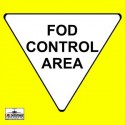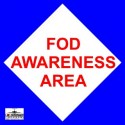The Concorde crash is so senseless because debris on the runway is one of the most preventable causes of damage to aircraft and plane crashes,” said Gary Chaplin, president of the Tucson, Ariz.-based FOD Control Corp.
The metal strip, which didn’t appear to belong to the Concorde, fit the shape of a cut in one of the tires, said investigators with France’s Accident Investigation Bureau. The tire apparently burst as the supersonic airline
 sped along the runway toward takeoff, throwing up pieces of rubber with massive force weighing up to nine pounds. Fuel tanks on the left wing were rapidly damaged, causing a major fuel leak and fire, the bureau reported.
sped along the runway toward takeoff, throwing up pieces of rubber with massive force weighing up to nine pounds. Fuel tanks on the left wing were rapidly damaged, causing a major fuel leak and fire, the bureau reported.
FOD prevention products range from magnetic sweepers to powerful vacuums that pick up everything from a grain of sand to large pieces of metal and chunks of concrete, asphalt and rocks. FOD experts recommend that airports continuously sweep during routine activity at any airport.
Many aviation operations still resort to a “FOD Walk,” where personnel line up and walk the runway looking for and removing debris.
“This is neither cost effective nor safe because the human eye can miss a lot of debris and sometimes the human attitude can lead to a failure in performance” said Chaplin. “This is just not a situation that should be left to chance.”
Foreign object debris ranges from nuts, bolts, safety wire and mechanics’ tools, to stones and sand, pieces of wood, plastic materials, and small animals. Anything that can be sucked into an engine or blown into the path of an aircraft’s mechanisms — flaps, landing gear, fan blades — is a recipe for engine failure or damage to other aircraft instruments.
Besides the safety issues, there’s the cost associated with FOD damage.
The organization National Aerospace FOD Prevention, Inc. estimates the cost of FOD to the international aerospace industry at $4 billion annually. These dollars are spent largely repairing aircraft engine damage caused by the ingestion of foreign objects from runways.
Prevention products and programs cost a fraction of what is spent on repairs, Chaplin explained. For example, the FOD*BOSS Speed Sweeper or FODBUSTER Rock Sweeper cost an estimated $7,000. Replacing FOD-damaged fan blades on only one aircraft engine can exceed that by tens of thousands. And, replacing an entire engine can easily run into millions.
“As improved training, awareness, along with prevention equipment and measures are incorporated into FOD prevention programs, the less likely it is a tragedy such as the Concorde will occur,” says Chaplin.
Update
In early September, French investigators said the metal strip apparently came from a Continental Airlines DC-10 that had taken off from the same runway minutes before the Concorde.



